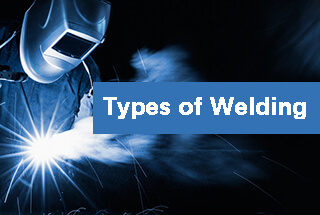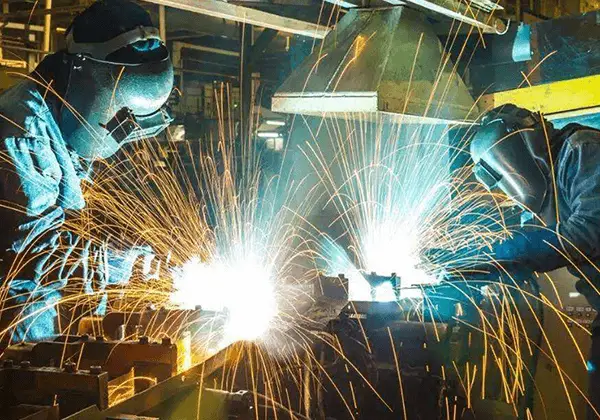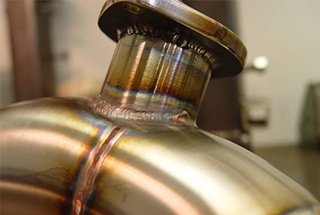Weldability and test evaluation
1. Welding
The process of combining atoms of two objects to form an indivisible whole by heating or pressurizing, with or without filling materials.
2. Weldability
It refers to the ability of homogeneous or heterogeneous materials to weld to form a complete joint and meet the expected service requirements under the manufacturing process conditions.

3. Four factors affecting weldability
Materials, design, process and service environment.
4. The principles for evaluating weldability mainly include:
① Evaluate the tendency of welding joint to produce process defects, so as to provide the basis for formulating reasonable welding process;
② Evaluate whether the welded joint can meet the requirements of structural performance; The design of a new welding test method meets the following principles: comparability, pertinence, reproducibility and economy.
5. Carbon equivalent
The content of alloy elements in steel is converted and superimposed according to several carbon contents, which is used as the parameter index for roughly evaluating the cold crack tendency of steel.
6. Oblique Y-groove butt crack test
It is mainly used to identify the tendency of cold crack formation in the first layer of weld and HAZ of low alloy high strength steel, and can also be used to formulate the welding process.
1) Specimen preparation, the plate thickness of steel to be welded δ= 9-38mm
The groove of the butt joint shall be machined by mechanical method, and the binding weld shall be welded within 60mm at both ends of the test plate, and double-sided welding shall be adopted. Pay attention to prevent angular deformation and incomplete penetration. Ensure that there is a 2mm gap at the weld of the sample to be welded in the middle.
2) Test conditions
The welding rod selected for the test weld shall match the base metal. The welding rod used shall be strictly dried.
The diameter of the welding rod shall be 4mm, the welding current shall be (170 ± 10) a, the welding voltage shall be (24 ± 2) V, and the welding speed shall be (150 ± 10) mm / min.
The test weld can be welded at various temperatures.
Only one test weld is welded without filling the groove.
After standing and natural cooling for 24h after welding, the sample shall be intercepted and crack detection shall be carried out.
3) Detection and crack rate calculation
Use the naked eye or hand-held 5-10 times magnifying glass to detect whether there are cracks on the surface and section of the weld and heat-affected zone.
It is generally believed that when the surface crack rate of low alloy steel in “small iron grinding” test is less than 20%, there is generally no crack.
7. Pin test
The purpose is to evaluate the tendency of hydrogen induced delayed crack in steel.
With other equipment, the reheat crack sensitivity and lamellar sensitivity can also be measured.
1) For specimen preparation, the pin test bar of welded steel or cylinder shall be sampled along the rolling direction, and the position of the pin in the thickness direction shall be indicated.
There is an annular or spiral notch near the upper end of the test bar. Insert the pin test bar into the corresponding hole of the base plate so that the end with notch is flush with the surface of the base plate.
For the pin test bar with annular notch, the distance between the notch and the end face shall make the weld bead penetration tangent or intersect with the cutting plane of the notch root, but the penetration of the circumference of the notch root shall not exceed 20%.
For low alloy steel, the value of a is 2mm when the welding heat input is e = 15KJ/ cm.
2) During the test, according to the selected welding method and strictly controlled process parameters, a layer of surfacing weld bead shall be melted on the base plate, and the centerline of the weld bead shall pass through the center of the sample.
Its penetration depth shall make the notch tip located in the coarse-grained area of the heat-affected zone, and the weld bead length L is about 100-150mm.
During welding, the T8 / 5 value of cooling time at 800-500 ℃ shall be measured. When welding is not preheated, it shall be loaded when it is cooled to 100-150 ℃ after welding;
During preheating before welding, it shall be loaded at 50-70 ℃ higher than the preheating temperature.
The load shall be applied within 1min and before cooling to 100 ℃ or 50-70 ℃ higher than the preheating temperature.
If there is post-heat, it shall be loaded before post heat. When the test bar is loaded, the pin may break within the load duration. Record the bearing time.

Weldability of alloy structural steel
1. High strength steel:
Steel with yield strength σs≥ 295mpa can be called high strength steel.
2. The solid solution strengthening effect of Mn is very significant
When ωMn≤ 1.7%, it can improve the toughness and reduce the brittle transition temperature, while Si will reduce the plasticity and toughness.
Ni is an element that can not only strengthen the solid solution, but also improve the toughness and greatly reduce the brittle transition temperature.
It is commonly used in low temperature steel.
3. Hot rolled steel (normalized steel):
Low alloy high-strength steel with yield strength of 295-490mpa, which is generally supplied and used in hot rolling or normalized state.
4. Design principle of welded joint of high-strength steel
High-strength steel is selected based on its strength, so the principle of the welded joint is: the strength of the welded joint is equal to that of base metal (equal strength principle).
Analysis:
① When the strength of the welded joint is greater than that of base metal, the plastic toughness is reduced,
② When the strength of the welded joint is equal to that of base metal, the service life is equivalent
③ When the strength of the welded joint is less than that of base metal, the strength of the joint is insufficient.
5. Weldability of hot rolled and normalized steel
Hot rolled steel contains a small amount of alloy elements, and generally has little tendency to cold crack.
Due to the large amount of alloy elements, the hardening tendency of normalized steel increases.
With the increase of carbon equivalent and plate thickness of normalized steel, the hardenability and cold crack tendency increase.
Influencing factors:
(1) Carbon equivalent
(2) Hardening tendency: the hardening tendency of hot rolled steel and normalized steel
(3) The highest hardness of heat affected zone is a simple method to evaluate the hardening tendency and cold crack susceptibility of steel.
6. SR crack (stress relief crack, reheat crack)
Another form of crack may appear in the process of post-weld stress relief heat treatment or post weld high-temperature heating for welded structures such as Mo normalized steel thick wall pressure vessels.
7. Toughness
Toughness is a property that characterizes the difficulty of metals in the generation and propagation of brittle cracks.
8. When selecting welding materials for low alloy steel, two aspects must be considered.
① There shall be no welding defects such as cracks, and
② It can meet the service performance requirements.
The welding materials of hot rolled steel and normalized steel are generally selected according to their strength level, and the key points are as follows:
① Select the welding materials of the corresponding level matching the mechanical properties of the base metal;
② Consider the influence of fusion ratio and the cooling rate at the same time;
③ Consider the influence of post-weld heat treatment on the mechanical properties of the weld.
9. Principles for determining the tempering temperature after welding
① Do not exceed the original tempering temperature of the base metal to avoid affecting the performance of the base metal itself;
② For tempered materials, avoid the temperature range where tempering brittleness occurs.
10. Quenched and tempered steel
Quenching + tempering (high temperature).
11. High strength steel welding
High strength steel welding adopts “low strength matching”, which can improve the crack resistance of the welding area.
12. Two basic problems should be paid attention to when welding low-carbon quenched and tempered steel
① It is required that the cooling rate during martensite transformation should not be too fast, so that martensite can have self tempering effect to prevent the generation of cold cracks;
② It is required that the cooling rate between 800 ℃ – 500 ℃ is greater than the critical rate for the generation of brittle mixed structure.
Problems to be solved in the welding of low carbon quenched and tempered steel:
① Prevent cracks;
② Improve the toughness of weld metal and heat affected zone while ensuring to meet the requirements of high strength.
13. Low-alloy steel with low carbon content
For low-alloy steel with low carbon content, increasing the cooling rate to form low-carbon martensite is beneficial to ensuring toughness.
14. Addition of alloying elements
The addition of alloying elements in medium carbon quenched and tempered steel mainly plays a role in ensuring hardenability and improving tempering resistance, while the true strength performance mainly depends on the carbon content.
Main features: high specific strength and high hardness.
15. There are three ways to improve the thermal strength of Pearlite Heat-resistant Steel:
① Matrix solid solution strengthening, adding alloy elements to strengthen the ferrite matrix, and the commonly used Cr, Mo, W and Nb elements can significantly improve the thermal strength;
② Second phase precipitation strengthening: in the heat-resistant steel with ferrite as the matrix, the strengthening phase is mainly alloy carbide;
③ Grain boundary strengthening: adding trace elements can be adsorbed on the grain boundary, Delay the diffusion of alloying elements along the grain boundary, so as to strengthen the grain boundary.
16. Problems in the welding of Pearlite Heat-resistant steel
The main problems in the welding of Pearlite Heat-resistant steel are cold crack, hardening and softening of heat affected zone, and stress relief crack in post weld heat treatment or long-term use at high temperature.
17. Temperature
The temperature range from – 10 ℃ to – 196 ℃ is called “low temperature”, and when it is lower than – 196 ℃, it is called “ultra-low temperature”.
Stainless steel welding
1. Stainless steel
Stainless steel refers to the general name of alloy steel with high chemical stability that can resist the corrosion of air, water, acid, alkali, salt and its solution and other corrosive media.
2. Corrosion forms of stainless steel
The main corrosion forms of stainless steel include uniform corrosion, pitting corrosion, crevice corrosion and stress corrosion.
Uniform corrosion refers to the corrosion of all metal surfaces in contact with corrosive media;
Pitting corrosion refers to the local corrosion that occurs dispersedly on the surface of metal materials without corrosion or slight corrosion;
Crevice corrosion: in the electrolyte, such as in the oxygen ion environment, when there is a gap between stainless steels or between surfaces in contact with foreign matters, the solution flow in the crevice will be delayed, so that the solution will locally Cl – and form a concentration cell, resulting in the local destruction of the stainless steel passivation film by adsorbing Cl – in the crevice;
Intergranular corrosion, a selective corrosion phenomenon near the grain boundary;
Stress corrosion refers to the brittle cracking of stainless steel under the action of specific corrosive medium and tensile stress.
3. Measures to prevent pitting corrosion:
1) Reduce the content of chloride ion and oxygen ion;
2) Add alloy elements such as chromium, nickel, molybdenum, silicon and copper into stainless steel;
3) Try not to carry out cold processing to reduce the possibility of pitting corrosion at dislocation outcrop; 4) reduce the carbon content in steel.
4. High temperature properties of stainless steel and heat-resistant steel:
Brittleness at 475 ℃, mainly in ferrite with Cr > 13%, long-term heating and slow cooling at 430-480 ℃, resulting in increased strength and decreased toughness at room temperature or negative temperature;
σ Phase embrittlement is typical of 45% mass fraction of Cr, FeCr intermetallic compound, non-magnetic, hard and brittle.
5. Corrosion resistance of austenitic stainless steel welded joints:
1) Intergranular corrosion,
2) Intergranular corrosion in heat affected zone and sensitized zone, and
3) Knife corrosion.
6. Measures to prevent intergranular corrosion of weld:
1) Make the weld metal become ultra-low carbon or contain sufficient stabilizing element NB through welding materials.
2) Adjust the weld composition to obtain a certain δ Phase. The theory of intergranular corrosion is essentially the theory of chromium deficiency.
7. Intergranular corrosion in heat affected zone and sensitized zone:
It refers to the intergranular corrosion in the welding heat affected zone where the heating peak temperature is in the sensitized heating range.
8. Knife corrosion:
Intergranular corrosion in the fusion zone is like knife cutting, so it is called “knife corrosion”.
9. Measures to prevent knife-like corrosion:
① Select low-carbon base metal and welding material;
② Adopt phase structured stainless steel;
③ Adopt low current welding to reduce the overheating degree and width of the welding coarse-grained zone;
④ Finally weld the weld in contact with the corrosive medium
⑤ Cross weld
⑥ Increase the content of Ti and TB in the steel to make the grain boundary of the welding coarse-grained zone have enough Ti, TB and carbonization.
10. Why does stainless steel adopt low current welding?
In order to reduce the temperature of welding heat affected zone, prevent the generation of weld intergranular corrosion, prevent overheating of welding rod and welding wire, welding deformation and welding stress, and reduce heat input.
11. Three conditions causing stress corrosion cracking:
Environment, selective corrosive medium and tensile stress.
12. Measures to prevent stress corrosion cracking:
1) Adjusting the chemical composition, ultra-low carbon is conducive to improving the ability of stress corrosion resistance, and the matching between composition and medium,
2) Remove welding residual stress
3) Electrochemical corrosion, regular inspection and timely repair, etc.
13. To improve pitting resistance:
1) On the one hand, the segregation of Cr and Mo must be reduced
2) On the one hand, the so-called “superalloyed” welding materials with higher CR and Mo contents than the base metal are used.
14. Austenitic stainless steel
Austenitic stainless steel will produce thermal cracks, stress corrosion cracks, welding deformation and intergranular corrosion during welding.
15. Causes of welding hot cracks of austenitic steel:
1) Austenitic steel has small thermal conductivity, large linear expansion coefficient and large tensile stress,
2) Austenitic steel is easy to form columnar crystal weld structure with strong directivity, which is conducive to the segregation of harmful impurities.
3) The alloy composition of austenitic steel is complex and easy to dissolve eutectic.
16. Measures to prevent thermal cracks:
① Strictly limit the content of P and s in base metal and welding materials
② Try to form a two-phase structure in the weld
③ Control the chemical composition of the weld
④ Low current welding.
17. What is the difference in weld microstructure between 18-8 and 25-20 types when preventing thermal cracks?
18-8 section steel weld formation A+ δ Organization, δ Phase can dissolve a large amount of P, S, δ The phase is generally 3% – 7%, and A + primary carbide structure is formed in the weld of 25-20 section steel.
18. Attention shall be paid to the following when selecting austenitic stainless steel:
① Adhere to the “applicability principle”
② Determine whether it is applicable according to the specific composition of each welding material selected
③ Consider the possible fusion ratio caused by the welding method and process parameters of the specific application
④ The alloying degree shall be determined according to the comprehensive weldability requirements specified in the technical conditions
⑤ Pay attention to the weld metal alloy system, the role of specific alloy composition in the alloy system, and consider the service performance requirements and process weldability requirements.
19. Weldability analysis of ferritic stainless steel:
1) Intergranular corrosion of welded joints
2) Embrittlement of welded joints, high temperature embrittlement, σ Phase embrittlement, embrittlement at 475 ℃.
Cast iron welding
1. Three characteristics of cast iron:
Vibration damping, oil absorption and wear resistance.
2. Properties of cast iron:
The properties of cast iron mainly depend on the shape, size, quantity and distribution of graphite, and the matrix structure also has a certain influence.
3. Nodular cast iron:
F matrix + spherical graphite;
Gray cast iron: F matrix + flake graphite;
Vermicular graphite cast iron: matrix + vermicular graphite;
Malleable cast iron: F matrix + flocculent graphite.
4. Can cast iron be welded with low carbon steel electrode?
No, during welding, even if the current is small, the proportion of base metal in the first weld is 25% – 30%.
If calculated according to C = 3% in cast iron, the carbon content in the first weld is 0.75% – 0.9%, which belongs to high carbon steel.
High carbon martensite appears immediately after welding cooling, and the welding HAZ will show white structure, which is difficult to machining.
5. Arc thermal welding:
The molten casting is preheated to 600-700 ℃, and then welded in the plastic state. The welding temperature is not lower than 400 ℃.
In order to prevent cracking during welding, stress relief treatment and slow cooling are carried out immediately after welding.
This cast iron welding repair process is called arc thermal welding.
6. Semi hot welding:
It is called semi hot welding when the preheating temperature is 300-400 ℃.


